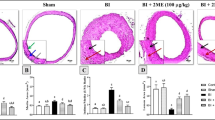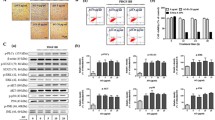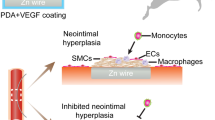Abstract
Purpose
Neointima formation following angioplasty is a serious consequence of endothelial damage in arteries. Inflammatory mediators and lack of endothelial regulatory mechanisms lead to migration and proliferation of smooth-muscle cells and thus to restenosis. This study examines the effect of the novel bis (aspirinato) zinc (II) complex on neointima formation in a rat model of carotid balloon-injury.
Methods
Rats underwent balloon-injury of the right common carotid artery, then received PEG400 vehicle (untreated-group), acetylsalicylic-acid (ASA-group), zinc-chloride (Zn-group) and bis (aspirinato) zinc (II) complex (Zn(ASA) 2-group) orally for 18 consecutive days. From harvested carotid arteries, histology, immunohistochemistry and mRNA expression analysis were performed.
Results
Compared to the untreated-group, Zn (ASA) 2-treatment significantly lowered stenosis ratio (54.0 ± 5.8 % to 25.5 ± 3.9 %) and reduced neointima/media ratio (1.5 ± 0.2 to 0.5 ± 0.1). Significantly higher alpha smooth muscle actin mRNA and protein expression were measured after Zn (ASA)2 and Zn-treatment in comparison with the untreated and ASA-groups while the expression of matrix-metalloproteinase-9 was significantly higher in these groups compared to Zn (ASA)2. The presence of collagen in media was significantly decreased in all treated groups. mRNA expressions of nuclear factor kappa-b, transforming growth-factor-β and proliferating cell nuclear antigen were significantly down-regulated, whereas a20 was up-regulated by Zn (ASA)2 treatment compared to the untreated and ASA-groups.
Conclusion
This study proves the effectivity of the novel bis (aspirinato) zinc complex in reducing neointima formation and restenosis after balloon-injury and supports the hypothesis that inhibition of smooth-muscle transformation/proliferation plays a key role in the prevention of restenosis.



Similar content being viewed by others
References
Jukema JW, Verschuren JJ, Ahmed TA, Quax PH. Restenosis after PCI. Part 1: pathophysiology and risk factors. Nat Rev Cardiol. 2012;9:53–62.
Jeremy JY, Rowe D, Emsley AM, Newby AC. Nitric oxide and the proliferation of vascular smooth muscle cells. Cardiovasc Res. 1999;43:580–94.
Ashino T, Yamamoto M, Yoshida T, Numazawa S. Redox-sensitive transcription factor Nrf2 regulates vascular smooth muscle cell migration and neointimal hyperplasia. Arterioscler Thromb Vasc Biol. 2013;33:760–8.
Austin KM, Nguyen N, Javid G, Covic L, and Kuliopulos A. Non-canonical MMP1-PAR1 Signaling Triggers Vascular Smooth Muscle Cell De-differentiation and Arterial Stenosis. J Biol Chem. 2013;
Simon DI. Inflammation and vascular injury: basic discovery to drug development. Circ J. 2012;76:1811–8.
Moreno PR, Bernardi VH, Lopez-Cuellar J, et al. Macrophage infiltration predicts restenosis after coronary intervention in patients with unstable angina. Circulation. 1996;94:3098–102.
Mickelson JK, Lakkis NM, Villarreal-Levy G, Hughes BJ, Smith CW. Leukocyte activation with platelet adhesion after coronary angioplasty: a mechanism for recurrent disease? J Am Coll Cardiol. 1996;28:345–53.
Clempus RE, Griendling KK. Reactive oxygen species signaling in vascular smooth muscle cells. Cardiovasc Res. 2006;71:216–25.
Daniel JM, Bielenberg W, Stieger P, et al. Time-course analysis on the differentiation of bone marrow-derived progenitor cells into smooth muscle cells during neointima formation. Arterioscler Thromb Vasc Biol. 2010;30:1890–6.
Reis ED, Roque M, Dansky H, et al. Sulindac inhibits neointimal formation after arterial injury in wild-type and apolipoprotein E-deficient mice. Proc Natl Acad Sci U S A. 2000;97:12764–9.
Prasad AS, Bao B, Beck FW, Kucuk O, Sarkar FH. Antioxidant effect of zinc in humans. Free Radic Biol Med. 2004;37:1182–90.
Bao B, Prasad AS, Beck FW, Godmere M. Zinc modulates mRNA levels of cytokines. Am J Physiol Endocrinol Metab. 2003;285:E1095–102.
Bao B, Prasad AS, Beck FW, et al. Zinc decreases C-reactive protein, lipid peroxidation, and inflammatory cytokines in elderly subjects: a potential implication of zinc as an atheroprotective agent. Am J Clin Nutr. 2010;91:1634–41.
Berger M, Rubinraut E, Barshack I, et al. Zinc reduces intimal hyperplasia in the rat carotid injury model. Atheroscler. 2004;175:229–34.
Singla AK, Wadhwa H. Zinc-Aspirin Complex Synthesis, Physicochemical and Biological Evaluation. Int J Pharm. 1994;108:173–85.
Yoshikawa Y, Adachi Y, Yasui H, Hattori M, Sakurai H. Oral administration of Bis (aspirinato)zinc(II) complex ameliorates hyperglycemia and metabolic syndrome–like disorders in spontaneously diabetic KK-A (y) mice: structure-activity relationship on zinc-salicylate complexes. Chem Pharm Bull (Tokyo). 2011;59:972–7.
Tahir H, Bona-Casas C, Hoekstra AG. Modelling the effect of a functional endothelium on the development of in-stent restenosis. PLoS One. 2013;8:e66138.
Block PC. Restenosis after percutaneous transluminal coronary angioplasty–anatomic and pathophysiological mechanisms. Strategies for prevention Circulation. 1990;81:IV2–4.
Hirschberg K, Radovits T, Loganathan S, et al. Selective phosphodiesterase-5 inhibition reduces neointimal hyperplasia in rat carotid arteries after surgical endarterectomy. J Thorac Cardiovasc Surg. 2009;137:1508–14.
Hirschberg K, Tarcea V, Pali S, et al. Cinaciguat prevents neointima formation after arterial injury by decreasing vascular smooth muscle cell migration and proliferation. Int J Cardiol. 2013;167:470–7.
Oinuma T, Yamada T, Sakurai I. Effects of copper-zinc type superoxide dismutase on the proliferation and migration of cultured vascular smooth muscle cells induced by oxidized low density lipoprotein. J Atheroscler Thromb. 1997;4:79–84.
Prasad AS, Bao B, Beck FW, Sarkar FH. Zinc-suppressed inflammatory cytokines by induction of A20-mediated inhibition of nuclear factor-kappaB. Nutr. 2011;27:816–23.
Masferrer JL, Needleman P. Anti-inflammatories for cardiovascular disease. Proc Natl Acad Sci U S A. 2000;97:12400–1.
Jugdutt BI. Cyclooxygenase inhibition and adverse remodeling during healing after myocardial infarction. Circ. 2007;115:288–91.
Clowes AW, Reidy MA, Clowes MM. Kinetics of cellular proliferation after arterial injury I. Smooth muscle growth in the absence of endothelium. Lab Investig. 1983;49:327–33.
Acknowledgments
The expert technical assistance of Patricia Kraft, Tobias Mayer and Samel Alsaid is gratefully acknowledged.
Funding
This study was supported by the Land Baden-Württemberg, Germany, by the Medical Faculty of the University of Heidelberg, Germany (to S. Korkmaz), by the School of PhD Studies, Semmelweis University, Hungary (to P. Hegedűs), and by the János Bolyai Research Scholarship of the Hungarian Academy of Sciences (to T. Radovits).
Author information
Authors and Affiliations
Corresponding author
Electronic supplementary material
Below is the link to the electronic supplementary material.
ESM 1
(DOC 67 kb)
Rights and permissions
About this article
Cite this article
Hegedűs, P., Korkmaz, S., Radovits, T. et al. Bis (Aspirinato) Zinc (II) Complex Successfully Inhibits Carotid Arterial Neointima Formation after Balloon-injury in Rats. Cardiovasc Drugs Ther 28, 533–539 (2014). https://doi.org/10.1007/s10557-014-6549-2
Published:
Issue Date:
DOI: https://doi.org/10.1007/s10557-014-6549-2




